| Origami Heaven A paperfolding
paradise
The website of
writer and paperfolding designer David Mitchell
x
|
| |
| Multipurpose Modules |
| |
Multipurpose
modules are modules whose configuration can be varied so
that they will go together to make a number of different
modular forms. New design work in this area may involve
the discovery / design of original multipurpose modules,
deriving new developments or variations from existing
ones or combining existing modules, new modules and new
derivations in original ways.
|
| |
| Developments
of the Sonobe Module |
| |
The Sonobe module was the original
multipurpose module. It was used by its inventor,
Mitsonobu Sonobe, to make, first the 6-part Cube, then
the 12-part Cube and the 12-part 8-point Stubby Star, the
modules for each of these forms being configured in
different ways. Both the latter configurations included a
diagonal crease across the central square area of the
module at right angles to the slit. We can call such
modules the Alpha version of the design.
It is
also possible to fold a Beta version of the module, in
which the diagonal crease across the central square area
runs in the alternate direction, ie along the line of the
slit rather than across it. A basic Beta Sonobe module
can be found in Origami for the Connoisseur by Kunihiko
Kasahara and Toshie Takahama, which was first published
in 1985.
Mirror-image
versions of both the Alpha and Beta forms of the module
are possible. Mirror-image forms often occur accidentally
when trying to fold large numbers of modules.
The
corner-pocket version of the design, where two opposite
corners are inverted to create pockets, was originated by
Tomoko Fuse in the mid 1980s.
Kunihiko
Kasahara originated another version of the Sonobe module,
which he called the Simple Sonobe module, in which two
opposite corners of the module are simply folded
backwards (nstead of being folded forwards and tucked in
or inverted).
One of
my own contributions, I believe, has been the development
of the Triangle Sonobe module where two adjacent (rather
than opposite) corners are folded inwards, inverted or
folded behind. Triangle Sonobes are not, however,
anywhere near as versatile as the Alpha or Beta versions.
Another
of my contributions has been the realisation that
different versions of the Sonobe module can be combined
within the same design to create Motley Sonobe designs.
Here
are some of my other developments of this versatile
module:
|
| |
 |
|
Name: The
Sonobe Silveroctahedron, which in its
most basic form, as pictured here, can be made by
combining two Alpha Sonobe modules with two Beta
Sonobe modules. This form will also collapse and
pop-up back into shape. Modules / Paper
shape / Folding geometry: From squares using
standard folding geometry.
Designer /
Date: David Mitchell, 1989
Reference:
Diagrams:
On-line diagrams are available on the Modular Designs page of this site
as part of the diagrams for my Ariadne modular
sculpture.
|
|
| |
 |
|
Name: Ariadne
modules (Corner-pocket Sonobe modules to
which the metamorphosis 1 distortion has been
applied) - Decorative development of the Sonobe
module which will make the same forms as the
original. Modules / Paper shape / Folding
geometry: From squares using standard folding
geometry.
Designer /
Date: David Mitchell, 1990
Reference:
064
Diagrams:
On-line diagrams are available on the Modular Designs page of this site
as part of the diagrams for my Ariadne modular
sculpture.
|
|
| |
| |
|
Name: Minos
modules (Corner-pocket Sonobe modules to
which the metamorphosis 2 distortion has been
applied) - Decorative development of the Sonobe
module which will make the same forms as the
original. Modules / Paper shape / Folding
geometry: From squares using standard folding
geometry.
Designer /
Date: David Mitchell, 1990
Reference:
064
Diagrams:
Not yet available.
|
|
| |
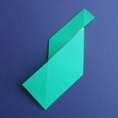 |
|
Name: Assymetric
Sonobe, Corner-Pocket Sonobe and Simple Sonobe
modules. These are a development of the
Sonobe module that will go together to create
unusually assymetrically patterned cubes, cube
combinations and silverhedra. The proportions of
the two assymetric elements of the module can be
varied. I also call the
corner-pocket version Mondrian modules.
When Mondrian modules of different proportions
are combined in the same design I call them Cockeyed
designs. Modules / Paper shape / Folding
geometry: From squares using standard folding
geometry.
Forms: 12
identical modules will go together to make a
Mondrian Cube, and 24, in two ways, to make a
Mondrian 8-point Stubby Star. It is not possible
to make a 20-point Stubby Star from assymetric
modules. The same forms can be made in Cockeyed
versions by combining sets of modules of
differing proportions.
Designer /
Date: David Mitchell, 1995
Reference:
119
Diagrams:
Synergy 3 - Water Trade // Diagrams for one
version of the module and the Mondrian Cube are
available on the Modular Designs page of this site.
|
|
| |
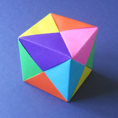 |
|
Name: Semi-Sonobe
modules. These modules will make all the
same forms as the original Sonobe module. They
are most easily made by the simple expedient of
cutting a Sonobe module in half. Modules / Paper
shape / Folding geometry: From 2x1 rectangles
using standard folding geometry.
Designer /
Date: David Mitchell, 2013
Reference:
354
Diagrams:
Not yet available.
|
|
| |
| Developments
of Nick Robinson's Rhombic Module |
| |
| Nick
Robinson's Rhombic Module is a version of the
Corner-Pocket Sonobe module folded from a sheet of A4
paper rather than from a square. In fact the design of
the module will work from any oblong. Here are some of my
developments of this design:
|
| |
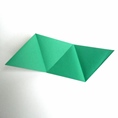 |
|
Name: Equilateral
Modules - a development of Nick
Robinson's Rhombic Module. These modules will
combine in basic and mirror-image forms to make
many robust deltahedra. A delta version is
also possible. Modules / Paper shape / Folding
geometry: From bronze rectangles using 60/30
degree folding geometry.
Designer /
Date: David Mitchell, 1998
Reference:
162
Diagrams:
In Mathematical Origami (2nd Edition) -
David Mitchell - Tarquin publications - ISBN
9781911093169
|
|
| |
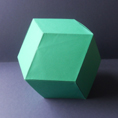 |
|
Name: Rhombic
Triangle modules - a triangular version
of Nick Robinson's Rhombic module. These modules
will combine to make several rhombic solids.
A four-pockets module is also possible.
Variants with other arrangements of flaps and
pockets are only possible if the paper is cut. Modules / Paper
shape / Folding geometry: From silver rectangles
using silver rectangle folding geometry.
Designer /
Date: David Mitchell, 2004
Reference:
267
Diagrams:
In Mathematical Origami (2nd Edition) -
David Mitchell - Tarquin publications - ISBN
9781911093169
|
|
| |
| Letterbox
Modules |
| |
| |
|
Name: Simple
Letterbox modules. All versions will go
together to create cubes, cube combinations and
silverhedra. Alpha, Beta, mirror-image and
triangular versions are possible. Modules / Paper
shape / Folding geometry: From 3x2 rectangles
using standard folding geometry.
Designer /
Date: David Mitchell, 1987.
Reference:
048
Diagrams:
Alpha modules - Synergy 2 - Water Trade //
On-line diagrams are available on the Modular Designs page of this site.
|
|
| |
| |
|
Name: Assymetric
Simple Letterbox modules. Modules / Paper
shape / Folding geometry: From 3x2 rectangles
using standard folding geometry.
Designer /
Date: David Mitchell, 1995.
Reference:
119
Diagrams:
Not yet available.
|
|
| |
| |
|
Name: Basic
Letterbox modules Modules / Paper
shape / Folding geometry: From squares using
standard folding geometry.
Designer /
Date: David Mitchell, 1987.
Reference:
048
Diagrams:
|
|
| |
| |
|
Name: Assymetric
Basic Letterbox modules Modules / Paper
shape / Folding geometry: From squares using
standard folding geometry.
Designer /
Date: David Mitchell, 1995.
Reference:
119
Diagrams:
Not yet available.
|
|
| |
| |
|
Name: Contrast
Pattern Letterbox modules - many
patterned variations. Modules / Paper
shape / Folding geometry: From squares using
standard folding geometry.
Designer /
Date: David Mitchell, 1989.
Reference:
048
Diagrams:
Alpha modules - Synergy 2 - Water Trade //
On-line diagrams are available on the Modular Designs page of this site.
|
|
| |
| Other
Original Multipurpose Modules |
| |
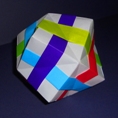 |
|
Name: Banded
modules. Various symmetric, assymetric
and doubly assymetric designs, all of which have
a coloured band in the centre and pockets on
either side beneath the band. Will go together to
make a variety of banded cubes and silverhedra
where the various differently coloured bands
appear to run right around the design. Modules / Paper
shape / Folding geometry: From squares using
standard folding geometry.
Designer /
Date: David Mitchell, 2001
Reference:
226
Diagrams:
On-line diagrams for one version of the module
are available on the Modular Designs page of this site.
|
|
| |
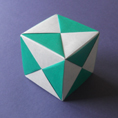 |
|
Name: Darwin
modules. The basic module has four white
flaps which can be used to create many patterned
variant modules including the well known Cyclone
module. The modules will go together to make a
wide variety of decorative cubes and silverhedra.
Modules of different patterns can easily be
combined within the same modular form. Modules / Paper
shape / Folding geometry: From squares using
standard folding geometry / based on division
into thirds..
Designer /
Date: David Mitchell, 2001
Reference:
231
Diagrams:
Synergy 2 - Water Trade // On-line diagrams are
available on the Modular Designs page of this site.
|
|
| |
 |
|
Name: Intersection
modules. Will go together to make many
inverted edge open frame designs. Modules / Paper
shape / Folding geometry: From squares / other
rectangles using standard folding geometry.
Designer /
Date: David Mitchell, 2003
Reference:
256
Diagrams:
Diagrams not yet available.
|
|
| |
 |
|
Name: Matrix
modules. Will go together to make
inverted edge open frame designs. Modules / Paper
shape / Folding geometry: From squares using
60/30 degree folding geometry.
Designer /
Date: David Mitchell, 2015
Reference:
372
Diagrams:
Diagrams not yet available.
|
|
| |
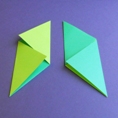 |
|
Name: Maverick
modules. Two mirror-image modules will
go together to form a Marriage of Opposites.
Maverick modules will also combine with Sonobe
and Letterbox modules to create Motley forms. Modules / Paper
shape / Folding geometry: From squares using
standard folding geometry.
Designer /
Date: David Mitchell, 1990
Reference:063
Diagrams:
On-line diagrams are available on the Modular Designs page of this site.
|
|
| |
 |
|
Name: Reptile
modules. Will go togeter to create
patterned deltahedra. Modules / Paper
shape / Folding geometry: From square using 60/30
degree geometry.
Designer /
Date: David Mitchell, 1997
Reference:
146
Diagrams:
First published in BOM 189 of April 1998 //
On-line diagrams are available on the Modular Designs page of this site.
|
|
| |
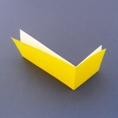 |
|
Name: Simplex
modules. These modules will combine to
make any solid shape whose faces are squares or
silver triangles. Modules / Paper
shape / Folding geometry: From squares using
standard folding geometry.
Designer /
Date: David Mitchell, 1988.
Reference:
035
Diagrams:
On-line diagrams are available on the Modular Designs page of this site.
|
|
| |
 |
|
Name: Simplified
Skillman modules. Combine to make
pierced designs based on a large variety of
polyhedral forms. Modules / Paper shape / Folding
geometry: From bronze rectangles using 60/30
folding geometry.
Designer /
Date: David Mitchell, 2003.
Reference:
258
Diagrams:
Diagrams not yet available
|
|
| |
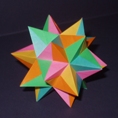 |
|
Name: Stella
Nova modules. Combine to make
multi-colour stars based on deltahedra.. Modules / Paper
shape / Folding geometry: From 4x1 rectangles
using 60/30 degree geometry.
Designer /
Date: David Mitchell, 2008
Reference:
322
Diagrams:
Not yet available.
|
|
| |
 |
|
Name: Vulcan
modules. Combine to make pierced stars
based on a large variety of polyhedral forms. Modules / Paper
shape / Folding geometry: From custom sized
rectangles using 60/30 folding geometry.
Designer /
Date: David Mitchell, 2008.
Reference:323
Diagrams:
Diagrams not yet available // Photo of Vulcan
icosahedron in Le Pli 113-114 - Mai 2009
|
|
| |
| |














